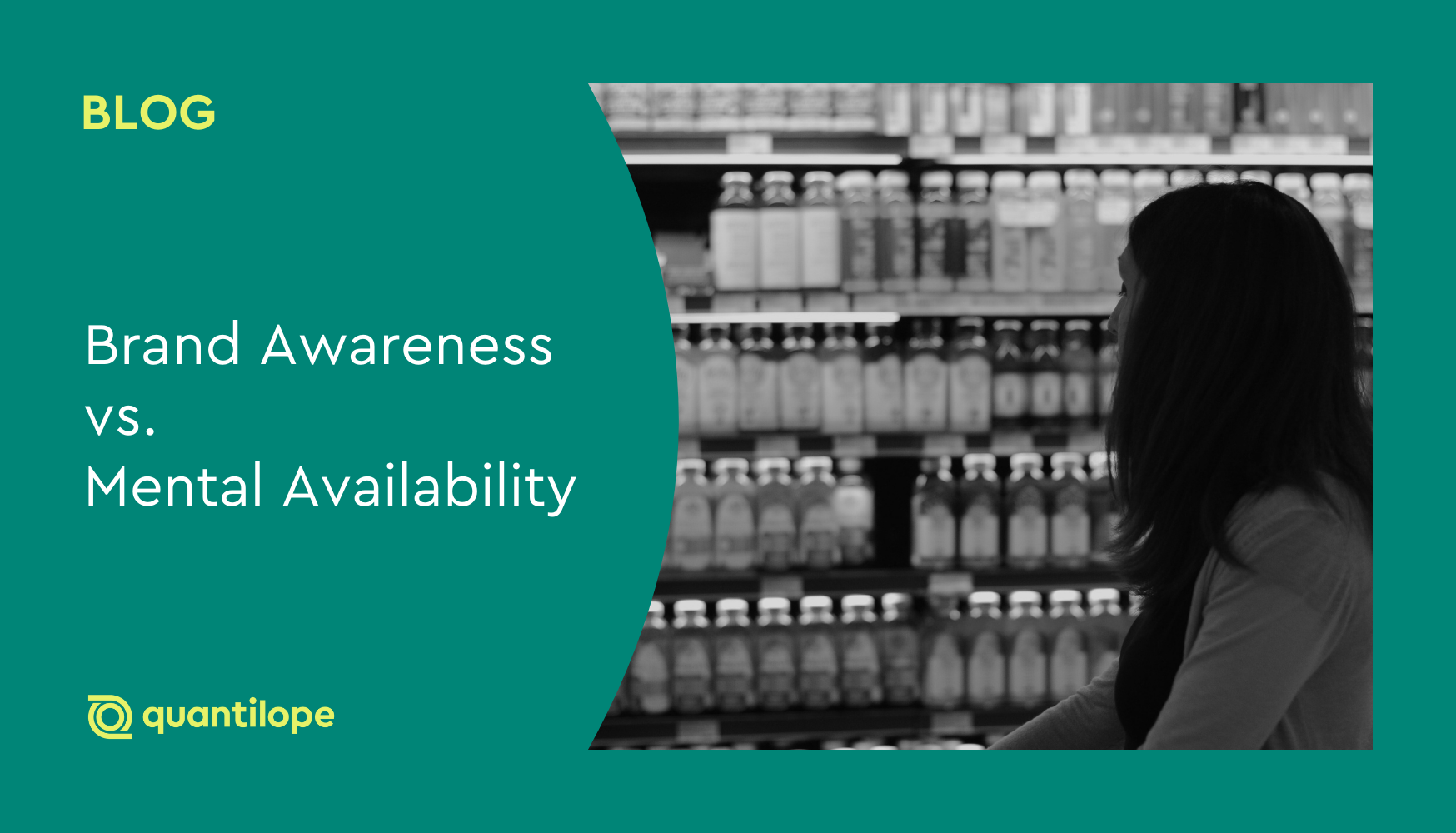In this post, learn what brand value is, how it differs from other key metrics such as brand equity, and key components that feed into brand value.
Key Takeaways:
- Brand value represents the monetary worth of a brand if sold – calculated through financial metrics like stock value, assets, cash flows, and market share compared to competitors.
- Brand equity focuses on customer perceptions and reputation, typically driving higher brand value through increased revenue.
- Companies measure brand value using three approaches: market-based valuation (stock comparisons), cost-based valuation (total business investments), and income-based evaluation (cash flow and profits).
- The Brand Value Chain model shows how marketing investments influence customer mindset, which drives market performance and ultimately creates shareholder value through four interconnected stages.
- quantilope's Consumer Intelligence Platform provides an end-to-end solution for measuring brand value, through a variety of tracking solutions and advanced methodologies to use in one-off studies. quantilope's Better Brand Health Tracking (BBHT) approach is particularly useful for brands to measure consumer perceptions and competitive positioning through Mental Availability and Mental Advantage analysis.
Table of Contents:
- What is brand value?
- Brand value vs. brand equity: How do they differ?
- Measuring brand value
- Key components influencing brand value
- How to build brand value
- How quantilope can help you build and measure brand value
What is brand value?
Brand value is essentially your brand worth from a monetary lens. It’s the price tag your brand would have if someone else were to buy it from you. It depends on things like company assets, intellectual property, market value (stock share value), and cash flows (sales, revenue, profit).
Many other factors of your brand not directly financially-related can influence value as well. Some of those other factors include brand awareness, brand perceptions, and brand loyalty (just to name a few). When these metrics are strong, brands attract better employees, secure more investor interest, and generate more revenue; that’s because consumers want to buy from reputable brands (and investors want to invest in the same).
Part of building a reputable brand has to do with brand identity - what your brand stands for and if it lives up to its word. A brand with a consistent brand identity instantly communicates higher brand value than one that’s all over the place with no cohesive tie. These latter brands are ones that are probably trying to do too much rather than focusing on their craft/industry. Staying genuine to your brand goes a long way in consumers’ eyes.
Once you have your brand identity in a solid place, focus on your audience. You want to make sure your customers have the best possible experience with your brand at all touch points. This includes in-store and online shopping, customer service interactions, and consumer-targeted advertisements. When customers have a positive experience with your brand, they have better overall brand perceptions which (as you might guess) feeds into stronger brand value.
Back to table of contents
Brand value vs. brand equity: How do they differ?
Brand equity is the reputation and perception customers have of a brand; it’s almost like a brand's mental value - what customers know about the brand, how they perceive it, etc. On the other hand, brand value is like the price tag of a brand. It's a tangible, financial measurement that's used to assess how much a brand is monetarily worth.
Here are some additional differences between brand equity and brand value:
-
Measurement: Brand value can be measured using a combination of financial and non-financial metrics. Financial metrics focus on the company's revenue, profits, market share, and stock value (whether public or private). Non-financial metrics, which often relate to brand equity, assess customer perception, loyalty, and brand strength through online surveys, focus groups, and social media analytics.
-
Influences: Brand equity is influenced by things like how well-known the brand is, how people perceive the brand, how loyal customers are, and what kind of experiences customers have. Brand value is influenced by things like how much money the brand makes, how much market share it holds, and what kind of assets it has.
-
Impact: Brand equity affects how customers behave toward the brand (i.e. if they recommend it to others or not) and how well it does comparative to competition. Brand value affects financial decisions - how attractive the brand appears to investors and how much money shareholders actually earn.
To sum up brand equity vs. brand value, brand equity generally refers to your brand reputation and customer loyalty. Brand value on the other hand is the financial worth of the brand: the market value (stocks) and book value (assets). Both are important for success, and are somewhat related; the most valuable brands are often ones with strong brand equity; when consumers and stakeholders think highly of your brand (brand equity), they’re more likely to spend more on the brand to earn the brand more money (brand value).
Back to table of contents
Measuring brand value
Knowing brand value is important, you might now be wondering how to measure brand value.
Because brand value is the monetary value of a brand, companies can look into financial sources such as stock value; compare this to what competitors are worth to see where you stack up (i.e., market-based valuation). You can also measure your value through a cost-based valuation - adding up everything you've put into the business from the start (expenses, marketing investments, employee costs, etc.). Lastly, you can of course look at your earnings (income-based evaluation); this is your brand's cash flow, savings, revenue, and profit.
Brand equity is also closely related brand value, so brands can take their own initiative to gather valuable brand insights through research that measures things like brand awareness, brand recall, brand preference, brand loyalty, and so on. All these metrics feed into brand equity letting a company know how they’re doing in consumers’ eyes. If brand equity is incredibly low, chances are brand value is too (and vice-versa).
Back to table of contentz
Key components influencing brand value
As mentioned above, brand equity and brand value are slightly different, yet related. If your ultimate goal is to increase brand value (how much your brand is worth on the books), it often starts with brand equity; below are just a few areas that influence the value of a brand even though they're not directly financially related:
-
Brand awareness: How well consumers know and recognize your brand. This can be measured using a regular brand tracking survey along with social media analytics, and website traffic. You’ll typically want to capture metrics from your target audience - existing and new customers that will likely be in the market for your category/brand (or that you hope will be).
-
Brand perceptions: The mental image that consumers have of your brand. This is influenced by factors such as advertising, customer service, and product quality. It can be measured through online surveys and online/in-person focus groups.
-
Brand consistency: The extent that your brand's messaging and brand identity is consistent across all channels and touch points. This can be measured through content analysis and customer feedback.
-
Brand loyalty: The tendency consumers have to repurchase your brand's products or services. This can be measured through enrollment in customer loyalty programs and customer retention (or alternatively, by looking at customer churn rates).
These brand tracking metrics are just a few of the many factors that feed into a brand’s overall equity and therefore, brand value. There's rarely just one component that makes or breaks brand value; it’s a culmination of many little things that form a strong end result.
Back to table of contents
How to build brand value
Brands can reference the Brand Value Chain model (developed by Kevin Lane Keller) when looking to build value. It breaks down the process into four main value areas, which relate to both brand equity (marketing and communications - indirectly building brand value through revenue) and financial assets (which more directly influence brand value).
-
Marketing programs investment:
As the initial stage in the Brand Value Chain, this is where a brand will develop consumer communications, invest in marketing and communication channels, and train their employees on external communication guidelines to build a successful marketing strategy. Everything within this stage should focus on the brand’s core values - such as its mission, vision, brand voice, and brand personality. Social media is a great way to add brand value as well, by increasing awareness and consideration for your brand. -
Customer mindset:
Marketing programs influence those who see them - aka your current and potential customers. In this stage, brands explore consumers’ mindsets, involving consumer awareness, associations, attitudes, and activities (i.e. word of mouth recommendations, or, net promoter scores). This is the stage where consumers begin to form brand perceptions - a crucial part in building up brand equity and thus, brand value. -
Market performance:
The market performance stage is where consumers begin to act as a result of marketing programs and newly-formed mindsets. Many factors can impact market performance, such as price elasticity, customer loyalty to the brand, brand overhead costs, and market share. All these aspects make a brand either appealing or unappealing to potential investors, which impacts shareholder value. -
Shareholder value:
Investors do a lot of brand valuation research before moving forward; they look at things like market performance, growth potential, risk, price ratios, stock prices, and so on.
Between each of these value stages are ‘multipliers’. These are things like program quality (how clear, consistent, and relevant marketing programs were), market place conditions (how competitors, channels, and customer profiles impact customer mindsets and market performance), and investor sentiment (financial implications such as market dynamics, growth potential, and risk).
The Brand Value Chain provides a linear view of brand building and highlights the interconnectedness of different brand strategy stages. By closely managing each stage, organizations can create strong brands that deliver high value to both customers and the organization itself.
Aside from the model, generally brands have success in building value when they focus on their customers and their needs. This can be done through effective and engaging advertising materials, ambassador programs to build credibility with the brand, and customer experiences at every brand touch point (from in-store shopping, to online user experience and customer service support).
Back to table of contents
How quantilope can help you build and measure brand value
quantilope’s Consumer Intelligence Platform, a comprehensive brand tracking software, is your end-to-end platform for uncovering insights around your brand. Whether you need ongoing brand tracking or a one-time brand health study, quantilope equips you with a hands-on approach to gather clear takeaways for better decision-making.
quantilope’s Better Brand Health Tracking solution is built based on the approach from The Ehrenberg-Bass Institute, giving brands a way to measure their brand health and market value through Mental Availability metrics. These metrics include share of mind, mental penetration, mental market share, and network size, all of which inform a brand of their place within a given category. Better Brand Health Tracking is a much more actionable and scientific approach to brand health tracking, going beyond basic brand funnel metrics for clearer business insights. With these takeaways, brands have a better idea of their brand equity and what their brand value might be stacked up against key competitors.
To learn more about how quantilope can help measure and understand your brand value, get in touch below!




